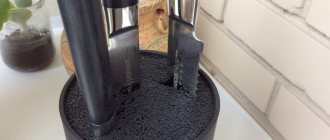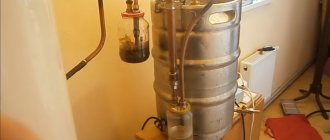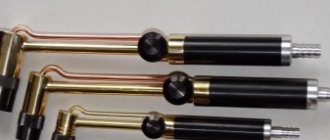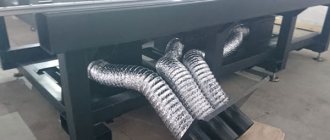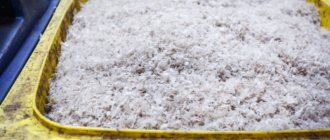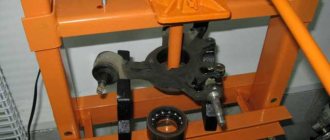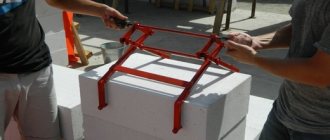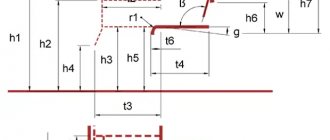The basic structure of a grinding machine
Without thorough knowledge of the design of grinding machines, it is impossible to assemble a high-quality device with your own hands. Before moving on to the structure, let's get acquainted with the most common types of grinders:
- Corner. Simply put, Bulgarian. Consumables are discs. Grinding wheels are designed for surface grinding. Pressure adjustment is carried out manually.
- Tape. Surface treatment is carried out with a sanding belt. Suitable for working on flat surfaces only.
- Delta sander. For processing products with a curved structure.
- Vibrating. Ideal for finishing smooth surfaces.
In addition to the above, there are several more devices that are less common:
- straight;
- polishing;
- eccentric.
Regardless of whether the device is factory-made or self-assembled, the main design elements are:
- Drive unit. The performance of the device depends on its power. Do-it-yourself devices use an electric drive, but there are pneumatic homemade ones powered by a compressor.
- Gearbox. Transmits torque from the drive to the working tool. The basic part of the gearbox is the spindle.
The gearbox is an integral part of tools such as an angle grinder or a drill. Some models, especially those assembled with your own hands, can do without it.
- Working platform. An abrasive material is attached to it. For this you can use circles, tapes, disks.
- Frame. Protects the structure from mechanical damage and dust, which is why many factory models are equipped with dust collection systems. The materials used to make a device with your own hands, as a rule, are not able to compete with high-quality polymers that are used in the production of professional tools.
- Control system. Includes turning off the power, as well as adjusting the abrasive speed.
Grinding machines - types and features of units
There are 3 types of grinders, which differ in specialization and functionality:
- use tape to remove large layers from large areas;
- surface grinders are used for finishing;
- eccentric ones work on the verge of polishing.
Many craftsmen who are professional grinders have the entire set of these tools in their arsenal. The vast majority of devices operate on 220 V. They are heavy and overheat. A pneumatic machine is lighter than an electric machine, but requires a source of compressed air. Such units are produced by a few companies, the most famous being Bosch.
Tape machines are “tanks” among similar devices
Such a grinding unit, with its working body in the form of an endless ring, resembles a tracked machine, and is also similar in shape. It is relatively powerful, its design is simple but reliable. From the engine, the sanding belt is driven through a gearbox and V-belt drive.
Works with all kinds of materials: wood, metal, polymers, minerals. Removes a few millimeters from the plane, makes curves and edges. The quality is not the best - an orbital (eccentric) or surface (vibratory) sander is required for finishing.
Performance directly depends on motor power. LSMs have motors of 0.5–1.2 kW. Another important indicator in the technical characteristics of these units is speed. A fast device will do more, but it will not be possible to press it due to the high torque. In addition, in this case there is not enough power. Responsible manufacturers have the most balanced indicators; the capabilities are often regulated by electronics.
Fast devices are usually low-power. If they are given more power, it will be difficult to operate, the cost will increase significantly, and if used inappropriately, it is easy to damage the part. High-speed lightweight machines can easily process large areas in a short time. If the upcoming load on the grinder is unknown, professionals recommend choosing a lower speed for home use that can be pressed down (the usual range of devices is 150–550 m/min). Even more convenient is a tape option with a pre-set speed mode, for example, Dewalt DW433.
Surface grinding units - the importance of the platform in the design
The devices occupy an intermediate place between belt and orbital tools in terms of processing purity. They are popular because of their affordable cost, the availability of additional equipment, and the ability to finish quite large areas, including corners. The motor is usually 150–300 W, but there is enough power.
The main thing in such an ESM is the plate moving in the forward-reverse direction with a high frequency. Key Features:
- The amplitude of the sole stroke, which is mainly 1–3 mm. There are models where it reaches 5–6 mm. Increasing the indicator leads to faster processing, but of lower quality.
- Platform stroke frequency. A thicker layer is removed at high rates, but when they are lower, grinding is more precise. Some devices, for example, Bosch GSS AEL-BOXX, have a speed of 20 thousand strokes per minute.
- Plate material and dimensions. According to the latter indicator, there are standard and mini (100 mm2). Budget models have a steel or plastic platform. Better made of porous polymer with low vibration.
Emery is attached differently. Velcro is more convenient, but they are more expensive. Spring-loaded clamps are more complex, but you can use paper cut by yourself.
Eccentric (orbital) machines – a guarantee of high-quality processing
They work both with a flat surface and with a profile, volumetric, curved, except for angular ones. The design is similar to the PShM, but the plate moves not only along the axis, but also orbitally with a slight amplitude, which is set by the eccentric. Complex movement and high speed ensure high-quality surface processing. Motors are usually 200–900 W: the more powerful, the greater the sole pull.
The speeds (amplitude and orbital) are also different. The same rule applies here as for other types of units: higher speed means more processing area per unit of time, but worse quality. The eccentric grinder is rich in electronics, which are used to perform various functions: frequency support, brake, limiting starting currents.
Making a grinder from a computer hard drive + ()
Any old hard drive can be converted into a miniature grinding machine. To do this you need to follow these steps:
- completely disassemble the hard drive and remove from the case everything that is located to the left of the magnetic disks;
- cut out a working circle from sandpaper, make a hole in the center of the circle for the spindle;
- stick several strips of double-sided tape onto the rotating disk of the hard drive and secure it with sandpaper;
- make a protective screen to protect the eyes from the possible ejection of the manufactured sanding disc;
- connect the finished design to the power supply from the computer and use it.
Of course, this design does not have high power, but it is quite possible to sharpen a small knife or scissors.
Repair of internal brush units of a grinder
Access the internal components and carefully pull out each brush assembly - be prepared for the brush to fly out. Press down on each brush to check its spring, then slide it out of the housing.
Replacement of internal brush units.
If the spring is damaged, the housing is cracked, the brush is worn, or is shorter than its width, then replace the component in each or both brush assemblies with exact duplicates.
Disconnect each assembly, replace the components, and then reinstall, making sure the brush fits snugly against the commutator and matches its curvature. Screw the housing back on and reinstall, reversing the removal procedure.
Making a grinder from a drill
To transform an ordinary, household electronic drill into a grinding machine, you need to equip it with a special attachment - a working drum or a special support plate, depending on the intended purpose.
The support is a plastic or rubber base with glued sandpaper and a shank for clamping. Discs with a flexible shaft are suitable for working with a loose drill, while those with a rigid shaft are best used only for a perfectly secured drill.
Sanding drums for a household drill are structurally an ordinary cylinder, a shank and sandpaper glued to the cylinder. Using drums, the working surface of the grinder is placed parallel to the axis of rotation.
Repair of rear drum mechanisms (belt sander)
To repair gears, start by dismantling the belt housing and removing the gear conveyor. If the drive conveyor does not rotate smoothly, you may suspect a damaged or dirty gear.
Access to gears: cleaning and replacing the grinder gear.
Unscrew the mechanism cover and remove it from the gearbox housing. (In the model shown, the drive pulley, pinion and pinion bearing are mechanically pressed.)
Wear safety glasses and remove the snap ring from the drive gearbox (insert) using pliers from the outer snap rings. Then remove the washers and drive gear from the rear drum drive shaft.
Cleaning the grinder gear.
Wearing rubber gloves, wipe them with a clean cloth. Use an old toothbrush soaked in paint thinner to clean the drive train and gear. Make sure the gear bearing rotates smoothly. If any component is damaged, replace it with an exact duplicate. (In the model shown in the figure, independent replacement is only possible with the drive gear.)
Fill the gear housing halfway with clean lubricant specified by the manufacturer. Reinstall the drive gear, washers, retaining ring, and gearbox cover. If the drive pulley does not rotate smoothly, check the key. Otherwise, reinstall the drive belt and its housing.
Inspection and repair of the rear drum of the sander
A loose or broken key may prevent the rear drum from turning smoothly. To begin repairs, unscrew the gearbox cover, remove the retaining ring, washers and drive gear.
Using long-nose pliers, remove the key from the keyway in the rear drum shaft (top). Inspect the key for damage; insert it into the gear keyway and then back into the shaft keyway. If the key is not damaged, inspect the rear drum assembly. Otherwise, replace the key with an exact duplicate. Reinstall the drive gear, washers and retaining ring. Make sure the gear housing is half filled with clean lubricant specified by the manufacturer. Reinstall the drive belt and its housing (installation)
Remove the key from the keyway and remove the washer. On the opposite side of the sander, pull out the rear drum. Remove the metal cover from the shaft. Inspect the rear shaft for dents or other damage; also inspect all metal components. If a component is damaged, replace it with an exact copy.
Replace the metal cap on the shaft, install the rear drum, and reinstall the washer. Reinstall the key into its keyway and replace the drive gear, washers and snap ring. Make sure the gear housing is half filled with clean lubricant specified by the manufacturer. Reinstall the drive belt and its housing.
Manufacturing algorithm
Considering that home machines will be interchangeable in terms of the type of processing, and the decisive role will be played by the attachment installed in the drill, we will consider two main options for home-made units - horizontal and vertical.
The procedure for assembling a vertical machine is as follows.
- Cut a square base 50 by 50 cm from a piece of metal or wood, with a thickness of 10 to 20 mm.
- Drill a hole in it exactly in the center at a distance of 1-2 cm from the edge for mounting the stand. The diameter of the stand must be at least 5 cm.
- Install the stand, center it using a level and weld it with a welding electrode. If you are making a wooden machine and the stand will be wooden, then firmly fix it with self-tapping screws.
- Using metal clamps, secure the drill to a movable element that will be put on the stand, forming a lowering/raising spindle.
- Place the spring on the strut. Its length must be at least 2/3 of the rack.
- Having placed the drill on the stand, mark the place where the drill will hit when lowering the spindle.
- According to this place, cut two through hollows in the frame crosswise.
- A table is installed in the groove on the threaded pin on which the workpiece will be mounted. A nut is screwed onto the pin from the bottom side; it will fix the table in the desired position. You can also attach the table to the pin from the outside with a nut, recessing it into the surface of the table so that it does not interfere with the placement of workpieces.
- It is important that after securing with a nut, the length of the outer part of the pin is flush with the top surface of the table.
The workpiece is placed on the table (fixed with clamps if necessary) and moved along the grooves in the desired direction. The drill is lowered manually and raised back up by a spring. To convert the machine into a milling or grinding machine, it is enough to replace the drill with a corresponding attachment - a milling cutter or a sanding block.
The assembly algorithm for a horizontal machine looks like this.
- Cut a rectangular frame - dimensions are determined individually.
- At one edge, secure a seat for a drill with a hollow in the upper part corresponding to the size of the tool.
- Secure the drill to it with a clamp.
- Cut a through groove for the pin along the frame, and install two metal corners along the edges along which the pressure sleeve will move.
- The width of the pressure sleeve must exactly match the distance between the guide angles (runners). A threaded pin is screwed into it from below, which will move in the hollow.
- By moving the sleeve close to the drill chuck, determine the place where the special headstock will be installed for fixing the workpieces.
- Attach the headstock to the bushing with a metal cone-shaped pin placed in the center.
- The sleeve is fixed in the desired position (for clamping the workpiece) with a nut screwed onto the pin from below.
Just like the previous one, this machine can be used not only as a lathe, but also as a milling or grinding machine. You just need to clamp the necessary working element in the drill chuck - a milling cutter, a sanding block, a drill.
In both options, it is necessary to provide special adjustable legs for the frame.
If the bed rests flat on a workbench or table, it will become impossible to adjust and fix the clamping sleeve on a horizontal machine or the workpiece table on a vertical one.
Repair of externally accessible brush units of a grinder
If there are no brush covers on the motor housing, replace the internal brush assemblies. Otherwise, unscrew each cap slowly.
Replacement of externally accessible brush units.
Be careful the brushes may fly out when the spring is loosened.
Pull each assembly out and push each one once or twice to check its spring. If the spring is damaged or the brush is jagged, uneven or worn shorter than wide, replace both assemblies with exact duplicates. Carefully place into place, making sure it matches the curvature of the switch; then screw the cap on.
How to Make a Sander From a Drill
How to make a sander
When work with a wooden surface comes to an end, the final sanding step begins. To perform grinding without burrs, scratches, and to perfectly round the sharp corners of any part, you need to use a wood sander. This tool will help to perform masterful grinding even for a new person who has picked up the device for the first time. If desired, perform the grinding machine independently, using only the means at hand.
Correct operation of equipment is the key to successful operation
The process of installing a wood sanding machine with your own hands must meet all the requirements of safety regulations. Every master should remember this in order to prevent injuries in the workplace:
The manufactured machine is made from high-quality materials and has a reliable design
During surface treatment, do not touch the working tool or moving parts of the mechanism with your hands. When working with homemade grinding equipment, you need to wear safety glasses. For woodworking, you cannot use discs designed for metal processing, since they have a different surface structure. Before starting work, it is important to check the serviceability of the structural parts. The use of a protective guard for grinding wheels increases work safety.
Do-it-yourself grinder from a drill
A belt grinding machine is used in cases where it is necessary to perform finishing processing of parts, that is, as equipment for carrying out finishing technological operations.
Most often, such machines are used in the furniture industry; they are used to process parts made from various types of wood.
But a belt grinding machine can also be used to process metal parts, for which a belt with an appropriate abrasive material is used.
Belt grinding machine
Application areas of the machine
The main tasks performed by the belt grinding machine are: final leveling of the surface being processed, bringing the level of surface roughness to the required level, bringing the processed surfaces to the level of smoothness before covering them with varnish and other finishing materials. The belt machine is also used to eliminate minor defects of the processed surface: depressions, elevations and burrs, processing the finishing coating: removing sagging primer and varnish, burr, grinding internal surfaces, processing roundings on the surface of the part.
A factory-produced option, the drawings of which can be used to create a similar homemade device.
The tape machine can be used for processing parts made of various materials: wood, plain and alloy steel, non-ferrous metals.
What’s convenient is that using a belt machine you can process parts that have different shapes: quadrangular, round and flat.
Using such equipment, it is possible to process round and tubular parts with a large cross-sectional diameter.
Design features of the machine
The working tool of any belt surface grinding machine is a belt on the surface of which abrasive powder is applied. It is made in the form of a ring and is placed between two rotating drums, one of which is the leading one and the second is the driven one.
Recommendations for the direction of rotation of the machine belt
Rotation to the drive shaft of the tape machine is transmitted from an electric motor, which is connected to it via a belt drive.
The speed of movement of the belt mechanism can be adjusted, thereby changing the processing modes of parts.
The belt of a surface grinding machine can be positioned horizontally or vertically, as well as at a certain angle, which is allowed by some models of equipment in this category.
When choosing a belt sanding machine model for processing a particular part, it is important to consider the length of the surface that needs to be sanded. It is much more convenient to process parts on such machines whose surface length is shorter than the length of the abrasive belt and work table. If such conditions are met, the quality of processing will be much higher.
A homemade version of the machine is not so difficult to implement in a home workshop
The belt grinding machine can have different designs: with a movable and fixed work table, with a free belt.
A separate category includes wide-belt equipment, the peculiarity of which is that their work table, which is also a feed element, is made in the shape of a caterpillar.
In those equipment models that have a work table in their design, the abrasive belt is located in a horizontal plane, and in equipment with a free belt that does not have a work table, it can have a different spatial position.
A mandatory structural element of any belt sanding machine, including a tabletop one, is an exhaust device, which is necessary to remove dust generated in large quantities during the processing process. Both a professional and any homemade grinding machine used in a home workshop or garage are powered by an electric motor.
Principle of operation
The main operating parameters of a belt sanding machine include the feed speed and the force with which the belt is pressed against the workpiece.
Parameters such as the degree of grain size of the abrasive belt should be selected depending on the material from which the workpiece is made, as well as the degree of roughness that the surface of the machined product should have.
https://www..com/watch?v=KNo6GXiM54s
The characteristics of the material being processed, in particular its hardness, primarily influence the grit size of the abrasive belt to be selected. Processing modes that are directly related to each other are feed speed and tape clamping force.
So, if grinding is carried out at high speed, but with insignificant pressing force of the abrasive belt, then some areas of the surface of the part may turn out to be untreated.
If, on the contrary, you increase the clamping force and reduce the feed speed, you may encounter the fact that burns and blackening of the material may appear in certain areas of the surface being processed.
Another variation of the machine - view from the working surface of the belt
The results of grinding are also influenced by how well the abrasive tape is glued together.
In order to obtain high quality processing and not encounter malfunctions in the operation of the belt machine, you should not use abrasive belts that are glued incorrectly or have torn edges.
When putting the tape on the equipment shafts, it should be positioned so that the overlapping end of the seam does not ride up against the surface of the workpiece, but slides along it. Learn more about gluing tape in the video below.
Any, including a manual grinding machine, must provide the ability to adjust the belt tension, which is ensured by moving a movable shaft that is not driven. Tape tension is a very important parameter, when choosing which you should follow the “golden mean” rule.
The main characteristic for determining the degree of tension of the tape is its deflection, which is measured by lightly pressing on its surface in a tense state.
A manual belt grinding machine can be serviced by one operator, who moves the work table with the workpiece and rotates it so as to bring all areas of its surface under the abrasive belt.
How to make a belt sander
Many home craftsmen and professionals are wondering how to make a grinding machine with their own hands. The reason for this question is quite simple: the high cost of serial grinding equipment, which not everyone can pay off if not used regularly.
In order to make such equipment, you will need several main components: an electric motor, rollers and a reliable frame. Naturally, drawings of such a device or a photo of it would not be superfluous. Also at the end of the article you can watch videos on assembling a tape machine on your own.
The motor for belt grinding equipment is not difficult to find; it can be removed from an old washing machine. You will have to make the frame yourself; for this you can use a sheet of metal with dimensions 500x180x20 mm.
Such a platform must be secured to the frame very securely using several bolts.
Another version of the bed
The efficiency of a belt sanding machine directly depends on the characteristics of the electric motor that is installed on it.
If you are planning to make a grinding machine with your own hands, then an electric motor with a power of 2.5–3 kW, developing about 1500 rpm, is quite suitable for you.
In order for the sanding belt to move at a speed of 20 m/s when using such a motor, the drums must have a diameter of about 200 mm. What’s convenient is that if you choose an engine with these characteristics, you won’t need to make a gearbox for your grinding machine.
The drive shaft is connected directly to the electric motor shaft, and the second - driven - must rotate freely on an axis, which is installed in bearing units. In order for the abrasive belt to touch the surface of the workpiece more smoothly, the section of the frame on which the driven shaft is installed should be made with a slight bevel.
You can make shafts for a belt sanding machine from a chipboard with minimal financial costs.
Simply cut square blanks of 200x200 mm in size from such a plate, drill central holes in them and place them on the axle with a package with a total thickness of 240 mm.
After this, all you have to do is grind the resulting package and make it into a round shaft with a diameter of about 200 mm.
Belt grinder from an angle grinder - device ideas
The drive is a small angle grinder, which costs a little, and almost everyone has. The manufacturing work is simple: you need to make a frame to mount the tool. They are different, so the bed will be different in each specific case. Other important components: the drive shaft and wheels for sandpaper - all made from waste materials, no turning required. All you need is some profile pipes, sheet metal, a welding machine and a grinder.
Schematic diagram and operation
The sanding belt in the device moves on rollers, to which rotation is transmitted from an electric motor. In this case, the grinder acts as the drive, but you can just as successfully use a drill or any suitable motor. They are attached to the frame with reliable fasteners.
The principle of the tape attachment
To prevent the belt from sagging, a tensioning mechanism with a spring is used, which is pulled onto one of the rollers. The stationary unit differs from the manual unit in the table for fixing the workpieces. Safety is ensured by a transparent acrylic screen.
Industrial model
There are factory-made tape attachments for grinders on sale. They give the impression of solid, powerful designs, but users complain about poor mounting, an excessively long belt, which requires a powerful motor to drive. So, for purely practical reasons, and not just because of the high cost, many people prefer to make the console themselves.
DIY Car Ideas
There are many creative options for recycling household power tools to expand functionality. How to make a belt sander from a grinder is shown in the drawing below.
The implementation of the second idea is more difficult. You first need to make a bracket for the drive - the shape and dimensions may be different. They measure the tool and think about how to secure it. For production, steel plates are used, which are bent with the letter “P”. The parts are welded. The main task of this unit is to securely hold the angle grinder.
The bracket is attached to the frame on hinges
The following photo shows a general view of the product. Here it is important to pay attention to 2 parts that serve to adjust the tool. This is a spring between the base and the bracket, which is used to tension the working tape. There are also bolts in the mount. They are needed to change the angle of the angle grinder. This is necessary in order to achieve a position where the abrasive belt will be in the center of the drive wheel and will not fly off it.
Next they make driven rollers - there are two of them. Take closed bearings, which are put on a bolt of suitable diameter and length, and secured with a nut. Cover the top with a piece of plastic pipe. The leader is a bicycle stand, which is installed to perform various tricks.
Leading video
The following photo shows the general appearance of the product. In front is a table made of a piece of sheet iron welded to the base. Parts are processed with fixation on it.
The device is ready for use. Legs are attached to the frame; the bottom can be covered with rubber.
Abrasive tape – where to get it?
It is better to use factory tapes, which have standard dimensions of length 610, 915, 1230 mm, width 50 and 100 mm. Then you won’t have to think about making it yourself. Any version of the emery belt must meet the requirements:
- have an elastic fabric base;
- have a durable abrasive;
- do not heat up during prolonged operation;
- stretch out, but remain intact.
The dimensions of the factory sanding belt can be larger, but for a homemade device you should not take anything longer than 1230 mm. Otherwise, the dimensions of the product increase significantly, and these are unnecessary problems.
Making your own grinding machine is quite possible. Implementing the options is not particularly difficult, the main thing is to choose a suitable drive.
How to make a belt sander
Many home craftsmen and professionals are wondering how to make a grinding machine with their own hands. The reason for this question is quite simple: the high cost of serial grinding equipment, which not everyone can pay off if not used regularly. In order to make such equipment, you will need several main components: an electric motor, rollers and a reliable frame. Naturally, drawings of such a device or a photo of it would not be superfluous. Also at the end of the article you can watch videos on assembling a tape machine on your own. The motor for belt grinding equipment is not difficult to find; it can be removed from an old washing machine. You will have to make the frame yourself; for this you can use a sheet of metal with dimensions 500x180x20 mm. One side of the frame should be cut very evenly, since it will be necessary to attach the platform on which the electric motor will be mounted to it. The platform for the electric motor should also be made of a sheet of metal with dimensions 180x160x10 mm. Such a platform must be secured to the frame very securely using several bolts.
Another version of the bed
The efficiency of a belt sanding machine directly depends on the characteristics of the electric motor that is installed on it. If you are planning to make a grinding machine with your own hands, then an electric motor with a power of 2.5–3 kW, developing about 1500 rpm, is quite suitable for you. In order for the sanding belt to move at a speed of 20 m/s when using such a motor, the drums must have a diameter of about 200 mm. What’s convenient is that if you choose an engine with these characteristics, you won’t need to make a gearbox for your grinding machine.
The drive shaft is connected directly to the electric motor shaft, and the second - driven - must rotate freely on an axis, which is installed in bearing units. In order for the abrasive belt to touch the surface of the workpiece more smoothly, the section of the frame on which the driven shaft is installed should be made with a slight bevel.
You can make shafts for a belt sanding machine from a chipboard with minimal financial costs. Simply cut square blanks of 200x200 mm in size from such a plate, drill central holes in them and place them on the axle with a package with a total thickness of 240 mm. After this, all you have to do is grind the resulting package and make it into a round shaft with a diameter of about 200 mm.
Drawings and detailed analysis of some parts of a machine made of wood.
Wood belt sander (click to enlarge)
In order for the tape to be located strictly in the middle of the shaft, the diameter of its central part should be 2–3 mm larger than at the edges. And to prevent the tape from slipping on the drum, it is necessary to wrap a layer of thin rubber on it, for which you can use an old tire from a bicycle wheel, having previously cut it along its entire length.
The sanding belt for such a machine, the optimal width of which should be 200 mm, is made from ordinary emery cloth. The standard cloth is cut into strips of the required width, and an abrasive tape is already glued from them. It should be borne in mind that the material is glued end-to-end; for this purpose, dense material is placed on the reverse side, which will strengthen the resulting seam. The properties of such a seam are greatly influenced by the glue; it must be of very high quality, then the material will not tear along the seam after a short period of use.
Several more options for manufacturing belt grinding machines can be seen in the video below.
https://youtube.com/watch?v=opM1afRob6o
Preparation of work on the manufacture of the machine
You need to think carefully about what you can assemble a drilling machine from. Prepare materials and parts that may be required during construction.
A ready-made drawing is selected from reference literature or on the Internet, or a new one is developed according to which the structure will be assembled.
First of all, it is necessary to calculate the place where the drill used will be located, and the amount by which the drill moves.
Check it out here too!
- How to make a homemade metal detector - the best diagrams, instructions. Review of proven options for creating a simple do-it-yourself metal detector
- How to choose a washing machine: advice from professionals, the main subtleties of choosing a reliable and high-quality machine. Types, types, programs and functions
- Homemade lanterns with your own hands: step-by-step instructions on how to make a beautiful and effective lantern (110 photos)
Design
There is nothing particularly complicated in the design of a belt grinder. The device consists of a motor, drive and guide rollers. A sanding or roughing belt of the required grain size is passed through them.
When the engine is turned on, the drive roller mounted on its shaft begins to rotate, and through the tensioned working belt, the rotation is transmitted to the guide rollers. By pressing the part to be processed in the working area against the belt, the operator performs the required operation, changing the position of the workpiece relative to the surface of the belt if necessary.
By adjusting the distance between the guide rollers, it is possible to process surfaces with defects of different depths. During prolonged use, the sanding belt may not stretch much. To compensate for possible slack, a tension mechanism is provided in the design on one of the rollers. Typically, such a function is assigned to a roller located at the same distance between the leader and the slave.
The grinding machine is supplied with a support table, which also serves as a surface for fixing the workpiece. As a rule, such a table should be able to rotate 90 degrees about one axis. In this case, it is possible to process two perpendicularly located planes without reinstalling the part on the support table.
Of course, a grinder control panel is required! For safety reasons, it is recommended to mount it on the machine frame in close proximity to the operator’s working area. Portable machines are equipped with a stand made of durable steel with mounting holes on the base, allowing you to fix the unit on a wooden surface.
If you look at the design details, you can immediately notice some visual instability of the assembled grinding device. The overhang of the side dimensions of the installed rollers significantly exceeds the supporting surface on the base. In addition, the absence of a support table makes it difficult to effectively process relatively large surfaces, and holding the part in a canopy is inconvenient and quite dangerous.
An increased length of the working belt leads to additional losses due to friction. It is necessary to use a higher power power unit in the drive, and this increases energy costs. The tension unit is simple and functional. Adjusting the tension is a matter of seconds. The machine comes with replaceable sanding attachments, which can be used for sanding even on internal surfaces. Despite this, the cost is 100 thousand rubles. makes me think.
Required materials and tools
The torque-creating element, and accordingly the main working part in each type of machine, is the drill. The type of processing will largely depend on the attachment installed in its cartridge. Therefore, identical materials will be needed to assemble them.
To assemble a lathe, grinding machine:
- rectangular metal or wooden base, bed;
- clamping sleeve;
- a clamping head, which will be attached to the drill chuck;
- runners for the pressure sleeve;
- seat for fixing the drill.
Materials for assembling a drilling and milling machine:
- square bed;
- a metal stand on which the spindle with the drill attached will move;
- a spring corresponding to the diameter of the rack;
- table for workpieces;
- pin for fastening the table.
Tools you will need:
Read also: What to do if you get a kitten
- screwdriver;
- pliers;
- hacksaw for wood or metal;
- fastening elements - bolts, screws, nuts;
- welding machine.
If you plan to make a metal machine, then a necessary condition will be the presence of a welding machine. Since the machine is intended more for home use, its drawings and dimensions of its component elements are set individually.
Making your own grinding machine
It is impossible to make a grinding machine yourself without knowledge of the design and types of tools. The most common grinders:
- corner or otherwise Bulgarian. Discs must be replaced. The surface is polished with cleaning wheels. You can manually adjust the pressure;
- tape. For use on flat surfaces only. The work is done with a sanding belt, suitable for woodworking;
- vibration Used at the stage of finishing smooth surfaces;
- delta sander. Suitable for products with a curved shape.
Less common tools are straight sanders, polishers, random orbit sanders, and brush sanders. The device, made at the factory or with your own hands, does not differ in design. The main elements can be identified:
- Drive unit. Its power regulates the performance of the device. Mostly an electric type drive is used, but there are pneumatic devices made with your own hands. They are powered by a compressor.
- Gearbox. A machine element present on an angle grinder or drill. The basic part is the spindle. It transmits torque to the tool. There are also models that do not have a gearbox.
- Working platform. Tapes, disks or circles are used under it. Serves for fastening abrasive materials.
- Frame. The function of this element is protection from damage and dust. Factory devices have dust collection systems. When made with your own hands, the material is not able to compete with the factory analogue, since the quality of the factory model is better.
- Control system. Regulates the speed and power of the device.
Making a homemade grinder is not as difficult as it might seem. The main criterion is the correspondence between the capabilities of the device and the planned work. To save money, it is better to take the components that are on hand. There is no point in buying spare parts. Then the device will be comparable in price to the factory model. Naturally, the quality of a tool from a store is better than a home-made machine and it is more logical to take a ready-made device. Let's consider grinding machines made from scrap materials.
From the Bulgarian
The grinder is designed for grinding. We can say that it is an angle grinder, but there are some subtleties. The tool copes well with rough work, for example, removing old paint, removing corrosion or stains on metal. For factory models, there are attachments that allow for more delicate cleaning. This is possible thanks to the different grain sizes of the sanding sheet. For household appliances, operation occurs only in one mode with speeds of up to 14-15 thousand per minute.
IMPORTANT: This speed is suitable for sawing materials, but is high for sanding work.
The motor of the grinder has too much power. You need extensive experience in polishing with an angle grinder, in the presence of special polishing discs and circles. For delicate work, for example, for polishing a car, an angle grinder is not suitable. One careless movement and there will be a hole in the transport. A grinding machine needs a power of 300-400W. A do-it-yourself grinder made from an angle grinder is heavier than its factory counterpart, but you can customize your homemade grinder to suit your needs, which will make using the machine easier.
You can make an attachment for a homemade sanding machine, which will allow you to turn the device into a small belt sander. This option does not use a protective casing. If there is no possibility and desire to create nozzles, you can change the speed. Independent change will require knowledge in radio engineering. We need to create a voltage regulator. The operating procedure is as follows:
- solder using a printed circuit board;
- thyristors are adapted to radiators;
- testing is being carried out. Connect the light bulb and turn the toggle switch. The light should fade out smoothly;
- The device is mounted under the tool casing.
On expensive devices you can adjust the speed, but they cost from 10,000 rubles.
From a drill
A household electric drill equipped with a special attachment can be converted into a grinder from a drill. Depending on the task, this may be a special plate or drum. Or make a belt sander out of the tool.
- Sanding pad. It is a plastic or rubber base with sandpaper and a tail for attaching to a drill. The flexible shaft is suitable for working with a loose drill. With hard ones, they are used with a well-fixed drill.
- Sanding drums. The drill attachment consists of a regular cylinder, sandpaper and a tail. When used, the axis of rotation is parallel to the working surface of the grinder.
- Belt sander. The drill operates as a drive. For production you will need: rods with and without threads, profile pipe, plywood, steel sheet, bearings, various hardware and wood glue. Before manufacturing, make sure that you have a metalworking tool, a device for sawing metal. The assembly diagram is publicly available.
Orbital sander
Can only be made from a broken orbital machine. The main problem in manufacturing is the rotation of the disk. Self-production is too problematic due to the rotation device. In addition, the factory version is not too expensive, and there is no point in wasting time on this kind of machine.
Belt sander
Making this tool is not at all difficult. Follow these steps to create a belt sander:
- selection of necessary parts and materials;
- making a reliable base for mounting the tool;
- installation of countertops;
- securing the racks with the drum and tensioner;
- mounting drums and motor;
- fastening the sanding tape.
Processing large parts requires creating a large copy of the grinding machine yourself. If you install an electric motor with a power of more than 2 kW and a rotation speed of about 1500 rpm, then this is enough to rotate a drum with a diameter of 20 centimeters. This device is already used to process parts about 2 meters long.
Homemade grinder from a computer hard drive
An old hard drive can be turned into a miniature grinder. The advantage of this model is the complete absence of investment, except for the cost of abrasive wheels. Follow the easy steps to create the device:
- disassemble the hard drive and remove everything to the left of the disks;
- take sandpaper and make a circle out of it with a hole for the spindle in the center;
- secure the sandpaper by gluing it onto the rotating disk of the hard drive;
- make a screen to protect your eyes from the sanding disc flying out;
- connect to the power supply and use.
The device allows you to do small jobs. For example, you can sharpen a drill, knife or scissors. The average rotation speed is about 7600 rpm, but it all depends on the hard drive manufacturer.
Cleaning and repairing the grinder drive belt
Turn off the machine and unplug it from the outlet. To get to the drive belt, unscrew the housing on the side of the sander and remove it.
Rotate the gear conveyor by hand to ensure it fits snugly and moves smoothly over the pulleys. If your model does not have this, perform maintenance on the gearboxes and rear drum. If the pulleys do not rotate smoothly or the drive belt is loose, worn or broken, remove it.
Cleaning the belt on a machine.
Otherwise, use an old toothbrush to clean the gear conveyor. Then screw the housing.
Grinder drive belt repair
To remove the drive belt, rotate it and remove it from the pulleys one rib at a time. If the pulleys are difficult to rotate, repair the gears and rear drum. If the drive belt is damaged, buy an exact duplicate.
Replacing belt drives with grinders.
To install the drive belt, slide it onto the pulleys one rib at a time, following the same procedure as removal. Then screw the housing.
Horizontal drilling machine
This device will be useful for carpenters and furniture makers who constantly work with wood. This machine allows you to make strictly perpendicular and even holes in wooden parts in a matter of seconds, without spending a lot of effort and time.
A device that allows you to work with a drill in a horizontal position is made of the following materials:
- chipboard;
- plywood;
- tree.
First you need to drill a small hole in a piece of plywood. Next, another piece of plywood is taken, into which screws are screwed, used to drill a hole for the drill chuck.
Make sure that the hole is as precise in diameter as possible, and to do this, measure the drill chuck. After this, you can make a round blank from a piece of wood. Next, you need to glue all the parts together using PVA glue. Then clamp the parts with clamps and let them dry completely, then strengthen the fastening by screwing in several self-tapping screws. Using a round wooden piece, the exact diameter of the chuck is adjusted.
The tabletop for the machine is made of chipboard. Holes are made in it that will fix the machine in the future. Using wooden waste, you need to make stops for the drill that follow the contour, size and shape of the power tool. Please note that the drill should “lie” on its side strictly in a horizontal plane. If necessary, measure the position of the drill using a hydraulic level.
Fixation of the drill is ensured by free-running screws. The tool is ready! After completing the final calibration, you can safely use it.
Minor repairs of an angle grinder
Reasons for the malfunction of the angle grinder.
If the tool does not start after pressing the start button, it is likely that the cause of the breakdown is a minor malfunction that can be fixed on your own. Diagnosis is best carried out according to the principle from simple to complex. Most often, the break point in the electrical circuit is the area from the power supply to the graphite brushes. During the repair process, you should remove the casing and test the circuit in the area where the electric current is supplied to the start button. If there is no current supply to the button terminals, the supply cable should be replaced.
If the electric current is supplied to the start button, but is not transported further, then the breakdown of the tool consists in the failure of the start button. If the button fails, it should be replaced. For this purpose, you should carefully disassemble the trigger mechanism and replace the start button. When connecting, you should pay special attention to the terminals, since incorrectly connecting them can lead to burnout of the tool windings.
How to read a schematic diagram of an electric angle grinder
To repair or maintain a tool, it is not enough to know only the list and tasks of the parts - you should learn to read the electrical diagram of the angle grinder. To a person far from electricians, this may seem like some kind of difficult task, but, in fact, there are no particular difficulties. The connection diagram for the grinder reads like this:
- Two stator windings not connected to each other are connected in series via a power cable to a 220 V power supply. The windings are turned on by a switch, which in turn is activated by pressing the start button.
- Two windings, connected in parallel to graphite electric brushes, go to the contacts of the rotor commutator, where the entire electrical circuit is closed. 90% of cases where an angle grinder fails is a consequence of an open circuit.
Electric angle grinder diagram
What should such a machine be like?
To polish a car, low speeds are required - approximately 1000-2000 rpm. But drills have a power of up to 3000 rpm, and the well-known “grinder” has even higher power - up to 11,000 rpm. This is a rather risky frequency at which varnish and paint crack and burn hopelessly, completely deteriorating. That's why the speed must be adjusted.
You will have to hold the polishing machine for quite a long time, so it should be comfortable and light. In this regard, the winner is the “grinder”, in which the rotating working shaft serves at an angle of 900; it is convenient for the master to hold it. It’s not for nothing that store-bought polishing machines have a voluminous handle that allows you to change the grip. It also has a special lock that blocks the power button, which greatly simplifies the work.
Peach coloring: 10 ideas for creating an incredibly delicate look
Capricorn and 3 other zodiac signs whose glass is always half empty
They wanted to clear the roof of snow and almost ended up under it: video
